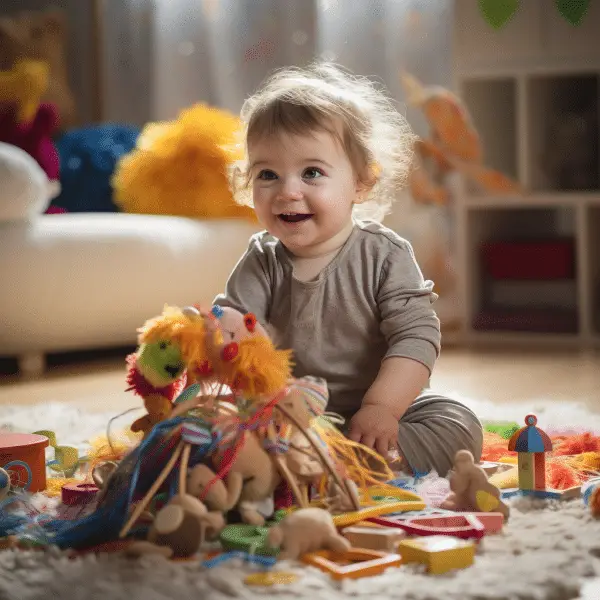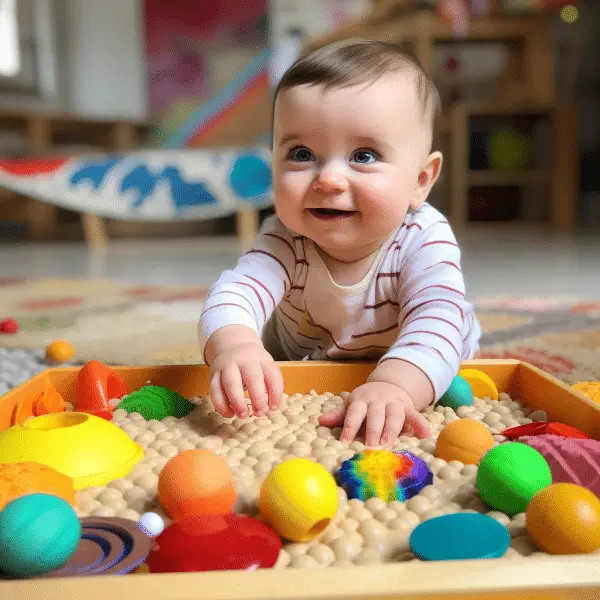Nurturing Infant Sensory Development Through Play
Play is an essential part of a baby’s development, providing them with opportunities to learn about themselves and their environment. It is through play that babies can explore their senses, discover new sensations, and make sense of the world around them. In this article, I will explore the importance of play in a baby’s learning and development, with a particular focus on sensory play. Join me as we delve into the fascinating world of exploring baby’s senses and discover the power of play in their development.
Key Takeaways:
- Play is a natural way for babies to learn about themselves and their environment.
- Guided play maximizes learning and promotes a healthy sense of identity and belonging.
- Play supports infant sensory development and allows babies to explore and stimulate their senses.
- Infant sensory play can be tailored to specific senses like touch, smell, taste, sight, and sound.
- Engaging in sensory play activities enhances a baby’s perceptual, cognitive, and emotional development.

The Importance of Play for Learning and Development
Play is an essential aspect of a child’s development, providing them with the opportunity to learn and grow in a natural and enjoyable way. Through play, children can engage their senses, develop their cognitive and motor skills, and explore their creativity. It is not just a recreational activity; it is a crucial tool for learning and development.
Research has shown that play promotes active learning, as it provides children with the energy, focus, and motivation needed to absorb new information and acquire new skills. Guided play, where adults initiate and organize play activities, has been proven to enhance learning outcomes even further. By creating stimulating play environments and offering developmentally appropriate materials and activities, adults can support children’s learning and create opportunities for them to explore and discover.
Attentive adults play a crucial role in guiding children’s play, helping them to focus their attention, play for longer periods, and learn more effectively. By actively participating in play and providing feedback and encouragement, adults can facilitate the development of essential cognitive, social, and emotional skills. Through play, children can practice problem-solving, decision-making, and communication, all of which are vital for their overall development.
| Benefits of Play for Learning and Development |
|---|
| Enhances cognitive skills |
| Improves motor skills and coordination |
| Promotes social interaction and communication |
| Fosters creativity and imagination |
| Facilitates problem-solving and decision-making |
In conclusion, play is not just a frivolous activity but a critical part of a child’s learning and development. By incorporating play into everyday routines and providing supportive and engaging play environments, we can foster children’s growth in various domains. Play allows children to explore, discover, and make sense of the world around them, promoting their overall well-being and setting a strong foundation for lifelong learning.
How Play Supports Infant Sensory Development
Play is a vital tool for supporting infant sensory development. Through play, babies can explore and stimulate their senses of touch, smell, taste, sight, and sound. They can learn about different textures, scents, flavors, colors, and sounds, which helps them make sense of the world around them. Playful activities such as sensory bins, object exploration, and music play can engage and enhance a baby’s sensory experiences.
Exploring the Senses Through Play
Infants learn and develop through their senses, and play provides the perfect opportunity for them to engage and explore. Sensory activities allow babies to use their senses to understand and interact with their environment. By providing a variety of materials and experiences, caregivers can promote a rich sensory play environment that boosts their baby’s development.
“Sensory play is a wonderful way for babies to discover and make sense of the world around them. Engaging their senses through play allows them to learn about different textures, smells, tastes, colors, and sounds, which are all important for their sensory development.”
Benefits of Sensory Play
Sensory play not only stimulates the senses but also promotes the development of various skills. When babies engage in sensory activities, they are refining their fine motor skills as they grasp, touch, and manipulate objects. They are also enhancing their cognitive abilities as they observe and process sensory information. Additionally, sensory play encourages language development as babies communicate their experiences and reactions.
| Benefits of Sensory Play | Skills Developed |
|---|---|
| Stimulates the senses | Sensory integration |
| Enhances fine motor skills | Grasping, manipulating objects |
| Promotes cognitive development | Observation, problem-solving |
| Encourages language development | Communication, vocabulary |
By incorporating sensory play into a baby’s daily routine, caregivers can support their overall development while providing a fun and engaging experience. Sensory play not only stimulates the senses but also fosters curiosity, creativity, and a love for learning, setting a strong foundation for future growth and development.
Exploring Baby’s Senses Through Touch
Touch is a fundamental sense that plays a crucial role in a baby’s sensory development. Engaging in activities that allow babies to explore different textures can enhance their tactile experiences and promote overall sensory development. By incorporating sensory play into their daily routine, caregivers can provide valuable opportunities for babies to engage their sense of touch and stimulate their cognitive and physical development.
The Importance of Tactile Experiences
Creating a tactile-rich environment is essential for babies to develop their sense of touch. When babies are exposed to a variety of textures, such as soft fabrics, rough surfaces, or smooth objects, they can explore the world through their sense of touch. These experiences help them develop their fine motor skills, hand-eye coordination, and body awareness. Tactile play also encourages sensory integration, which is the ability to process and organize sensory information from the environment.
Sensory Play Ideas for Exploring Touch
There are several sensory play activities that can stimulate a baby’s sense of touch. Here are some ideas to incorporate into your playtime:
- Create a sensory bin filled with different materials like rice, pasta, or sand for babies to explore with their hands.
- Provide textured toys such as sensory balls, soft plush toys, or rattles with various surface patterns.
- Introduce water play sessions where babies can splash and explore different water temperatures and textures.
Remember to always supervise babies during sensory play and ensure that the materials used are safe and age-appropriate. Sensory play should be a fun and engaging experience for both babies and caregivers, encouraging bonding and promoting developmental growth.
| Sensory Play Materials | Benefits |
|---|---|
| Soft fabrics | Enhances tactile experiences |
| Sensory balls | Develops fine motor skills |
| Water | Stimulates sensory exploration |
Stimulating Baby’s Sense of Smell
When it comes to sensory play for babies, stimulating their sense of smell can be a delightful and enriching experience. Babies have a keen sense of smell, and engaging in activities that involve pleasant scents can help them explore the world through their olfactory senses. Introducing babies to different smells through sensory play can enhance their sensory experiences and contribute to their overall development.
There are various ways to incorporate olfactory experiences into playtime. Scented playdough, for example, allows babies to engage their sense of smell while enjoying the tactile sensation of molding and shaping. Another idea is to create scented bottles using safe and baby-friendly scents. Babies can explore these bottles by sniffing, shaking, and listening to the sounds they make.
Parents and caregivers can also introduce scented toys that are specifically designed to stimulate a baby’s sense of smell. These toys often feature different scents and textures, encouraging sensory exploration and engagement. By incorporating smell development into sensory play, caregivers can provide a multi-sensory experience that promotes cognitive and sensory development in babies.
Benefits of Stimulating Smell Development in Babies
Stimulating a baby’s sense of smell through sensory play offers several benefits. Firstly, it helps babies become more aware of their surroundings and the different scents they encounter. This increased awareness contributes to their sensory development and understanding of the world.
Furthermore, engaging a baby’s sense of smell can also evoke emotional responses. Certain scents, such as lavender or vanilla, are known for their calming effects. By incorporating these scents into sensory play, caregivers can create a relaxing and soothing environment for their little ones. Exploring different smells can also spark curiosity and foster a sense of wonder in babies, promoting their cognitive and emotional growth.
In conclusion, sensory play that incorporates olfactory experiences is a valuable way to engage and stimulate a baby’s sense of smell. By providing scented materials, toys, and opportunities for exploration, caregivers can create a multi-sensory environment that supports sensory development, cognitive growth, and emotional well-being in babies.
| Benefits of Stimulating Smell Development in Babies |
|---|
| Increased sensory awareness: Stimulating a baby’s sense of smell helps them become more aware of their surroundings and different scents. |
| Emotional responses: Certain scents can evoke emotional responses in babies. Incorporating calming scents into sensory play can create a relaxing environment. |
| Curiosity and wonder: Exploring different smells sparks curiosity and fosters a sense of wonder, promoting cognitive and emotional growth. |
Developing Baby’s Sense of Taste
When it comes to a baby’s sensory development, the sense of taste plays a significant role in their exploration and understanding of the world. By providing safe and age-appropriate opportunities for babies to taste different flavors and textures, parents and caregivers can promote their taste development. Introducing a variety of solid foods can help babies explore and expand their palate, while also promoting healthy eating habits from an early age.
Sensory activities that involve edible materials, such as finger painting with safe and edible paints, can further enhance a baby’s oral exploration and sensory experiences. This allows them to not only engage their sense of taste but also improve their fine motor skills through tactile play. It’s important to supervise babies closely during these activities to ensure their safety.
Table:
| Safe Foods for Taste Exploration | Unsafe Foods for Babies |
|---|---|
| Soft fruits and vegetables, such as mashed bananas or steamed carrots | Honey (should not be given to babies under 1 year old) |
| Unsalted and mashed avocados | Salty or heavily spiced foods |
| Finger foods like cooked pasta or small soft pieces of cooked chicken | Certain allergenic foods (consult with a pediatrician before introducing) |
Introducing New Tastes Gradually
When introducing new tastes to babies, it’s important to do so gradually. Start with small amounts of a single food, offering it several times before moving on to the next. This helps babies become familiar with the taste and allows them to develop preferences. It’s normal for babies to reject certain foods at first, but continued exposure can lead to acceptance.
Remember, mealtime should be a positive and enjoyable experience. Create a relaxed and supportive environment, offering encouragement and praise for their exploration of new tastes. By incorporating a variety of flavors and textures into a baby’s diet, caregivers can foster a healthy relationship with food and lay the foundation for a diverse and balanced diet as they grow.
Engaging Baby’s Sense of Sight
Babies are naturally drawn to visual stimuli, and their sense of sight plays a crucial role in their overall development. By providing babies with stimulating activities that support their visual development, caregivers can help enhance their ability to perceive and understand the world around them.
One way to engage a baby’s sense of sight is by offering colorful toys and objects. Bright colors and contrasting patterns can capture a baby’s attention and stimulate their visual perception. Mobiles, for example, can provide a captivating visual display as they move and sway, encouraging babies to track and follow the objects.
Another activity to promote visual development is exploring the surroundings. Taking babies for walks outside or allowing them to explore different indoor environments can expose them to a variety of visual stimuli, such as different shapes, sizes, and textures. This exploration helps babies develop their visual discrimination skills and learn to recognize and distinguish between different objects.
Examples of Activities to Stimulate Baby’s Sense of Sight
- Playing peekaboo: This classic game not only brings joy and laughter but also helps babies understand object permanence and develop their visual tracking skills.
- Using age-appropriate books with high-contrast images: Books with contrasting colors and simple shapes can captivate a baby’s attention and promote visual exploration.
- Creating sensory bottles with colorful objects: Filling clear bottles with various materials and liquids in different colors can create visually stimulating objects for babies to observe and explore.
“Engaging a baby’s sense of sight through playful activities not only supports their visual development but also enhances their overall cognitive growth. By providing babies with visually stimulating experiences, caregivers contribute to their understanding of the world and lay the foundation for future learning.”
It’s important to remember that each baby is unique, and their visual development will progress at their own pace. Caregivers should provide a safe and stimulating environment, offer a variety of visually engaging activities, and observe and respond to their baby’s cues and interests. With time and exposure to different visual stimuli, babies will continue to refine their visual skills and gain a deeper understanding of the world around them.
| Activity | Description |
|---|---|
| Playing peekaboo | This classic game helps babies develop visual tracking skills and understand object permanence. |
| High-contrast books | Books with contrasting colors and simple shapes can promote visual exploration and stimulate the sense of sight. |
| Sensory bottles | Filling clear bottles with visually engaging materials and liquids can provide babies with captivating visual experiences. |
Stimulating Baby’s Sense of Sound
Babies are naturally drawn to sound and can benefit greatly from activities that support their auditory development. Engaging in various play experiences that involve listening to different sounds, playing musical instruments, singing songs, or using simple sound-making toys can stimulate their sense of sound and enhance their auditory exploration.
Sound Exploration
Through play allows babies to become familiar with different auditory stimuli and helps them develop their ability to identify and discriminate between sounds. It also promotes language development by exposing babies to various sounds and rhythms. Moreover, sound play can be a source of enjoyment and relaxation for babies, helping them to regulate their emotions and create positive associations with different sounds.
Playful Activities
Here are some ideas for stimulating your baby’s sense of sound through playful activities:
- Create a sound basket filled with items that make different sounds, such as rattles, bells, crinkly toys, and musical toys. Encourage your baby to explore and interact with the objects, allowing them to experience the different sounds they produce.
- Use your voice to sing songs, make different sounds, or read aloud to your baby. This not only exposes them to different vocal tones and patterns but also strengthens the bond between you and your baby.
- Introduce your baby to different musical instruments, such as drums, shakers, or xylophones. Encourage them to experiment with the instruments and explore the sounds they can create.
“Sound exploration through play allows babies to become familiar with different auditory stimuli and helps them develop their ability to identify and discriminate between sounds.”
Remember, babies learn through play, and providing them with opportunities to explore and engage their sense of sound can have a profound impact on their overall development. Make sure to create a safe and conducive environment for your baby’s auditory exploration, and always supervise their playtime activities.
| Activity | Description |
|---|---|
| Create a sound basket | Fill a basket with objects that produce different sounds, such as rattles, bells, and crinkly toys. Encourage your baby to explore and interact with the objects to experience the various sounds they make. |
| Sing songs and make sounds | Use your voice to sing songs, make different sounds, or read aloud to your baby. This exposes them to a range of vocal tones and patterns, supporting their auditory development and strengthening the parent-child bond. |
| Introduce musical instruments | Give your baby the opportunity to experiment with different musical instruments, such as drums, shakers, or xylophones. This allows them to explore the sounds they can create and enhances their musical awareness. |
Promoting Emotional Development Through Play
Play is a valuable tool for promoting emotional development in babies. Through play, babies have the opportunity to explore, express, and communicate their feelings. Playful interactions with caregivers, such as making faces or playing peekaboo, help babies learn about emotions and build a strong emotional bond. Musical play, messy play, and using puppets or toys to explain emotions are effective ways to encourage emotional expression and understanding.
When it comes to promoting emotional growth through play, music plays a significant role. Singing lullabies or playing soothing melodies can have a calming effect on babies, helping them regulate their emotions and establish a sense of security. Musical play also enhances cognitive development and stimulates creativity in babies.
Messy play, such as finger painting or playing with water and sand, allows babies to explore different textures and sensations. This type of play promotes sensory development while also providing an opportunity for emotional expression. Babies can freely express themselves through the exploration of different materials, helping them release and process their emotions.
“Play is the highest form of research.” – Albert Einstein
Using puppets or toys to explain emotions can be a helpful way to teach babies about different feelings. By acting out different scenarios and using expressive toys, caregivers can help babies understand emotions like happiness, sadness, and anger. This type of play promotes empathy and emotional intelligence in babies, laying the foundation for healthy emotional development.
Examples of Activities to Promote Emotional Development:
- Create a musical playtime using instruments and songs to help babies express their emotions.
- Engage in messy play with safe materials like edible finger paints or water play to encourage emotional release and exploration.
- Use puppets or toys to act out different emotions and teach babies about feelings.
| Benefits of Promoting Emotional Development Through Play |
|---|
| Enhances emotional expression and understanding |
| Builds a strong emotional bond between caregiver and baby |
| Develops empathy and emotional intelligence |
| Helps babies regulate their emotions and establish a sense of security |
| Promotes cognitive development and creativity |
Conclusion
Exploring a baby’s senses through play is a crucial aspect of their overall development. By engaging in various sensory play activities, caregivers can enhance a baby’s perceptual and cognitive skills, as well as promote their emotional well-being. Play not only supports learning and sensory development but also plays a vital role in fostering emotional growth in infants.
Through guided play, caregivers can create a stimulating environment that encourages babies to explore and learn about themselves and their surroundings. From tactile experiences to olfactory, taste, visual, and auditory stimulation, each sensory activity contributes to a baby’s sensory development. Additionally, play helps babies express and understand their emotions, building a strong emotional bond between the caregiver and the child.
It is important to remember that play should be flexible and adjusted to accommodate different developmental levels and abilities. By providing choices and opportunities for babies to engage in playful interactions, caregivers can maximize the learning and developmental benefits of play.
So, whether it’s through sensory bins, object exploration, or music play, incorporating play into a baby’s daily routine can have a profound impact on their growth. Ultimately, by prioritizing play and creating a playful and stimulating environment, caregivers can support the optimal sensory and emotional experiences for their little ones, setting them on a path of healthy development.
FAQ
What is the importance of play for learning and development in babies?
Play is a natural and effective way for babies to learn about themselves and their environment. It provides energy, focus, and motivation for learning, and promotes healthy development in various areas.
What is guided play?
Guided play is a type of play in which an adult facilitates and organizes play for the child. It maximizes learning opportunities and helps babies engage in more productive play.
Do babies have preferences when it comes to play?
Yes, babies have preferences and engage in more productive play when given choices. It is important to provide them with options and let them explore and express their preferences.
Is play flexible and adjustable to different developmental levels and abilities?
Yes, play is flexible and can be adjusted to accommodate different developmental levels and abilities. It is important to provide developmentally appropriate materials and activities to support each baby’s unique needs.
How does play promote a healthy sense of identity and belonging?
Play encourages self-expression and exploration, allowing babies to develop a sense of their own identity. It also provides opportunities for social interaction and connection, promoting a sense of belonging.
Can play incorporate different languages and cultures?
Yes, play is a universal language that can easily incorporate different languages and cultures. It provides a platform for cultural exchange and understanding, promoting diversity and inclusivity.







